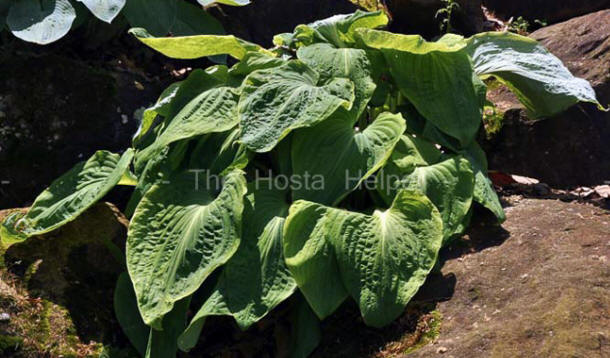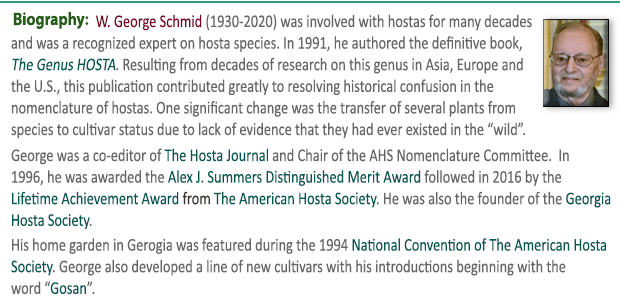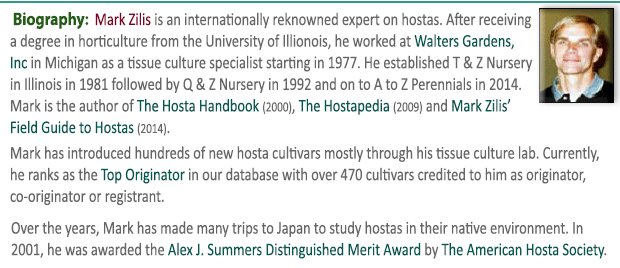|
  This species from
Japan grows
to a medium size
about 15 inches high and 47 inches wide. The leaf is deeply lobed
at the base with a curled tip and slightly rippled margins with
thick substance. One of the featured traits is the curve petiole
with dark reddish purple dots. Pale lavender, funnel shape flowers
with dark purple anthers bloom from
late July into August. It produces viable seeds. This species from
Japan grows
to a medium size
about 15 inches high and 47 inches wide. The leaf is deeply lobed
at the base with a curled tip and slightly rippled margins with
thick substance. One of the featured traits is the curve petiole
with dark reddish purple dots. Pale lavender, funnel shape flowers
with dark purple anthers bloom from
late July into August. It produces viable seeds.
The Genus Hosta by
W. George Schmid (1991) says the name in Greek translates to "hypo =
back, beneath and leucon = white color." This plants
gray-green leaves have long points at the tips and are whitish
colored on the bottoms.
 This species is native to
Japan, where it has adapted to growing on cliffs and rock
faces. The white underside of the leaves is thought to help
reflect the heat from the rocks. Schmid points out that "In Japan it is often used in elevated pots to show the very white
coating of the leaf underside or to provide an accent at the
entrance to the garden." This species is native to
Japan, where it has adapted to growing on cliffs and rock
faces. The white underside of the leaves is thought to help
reflect the heat from the rocks. Schmid points out that "In Japan it is often used in elevated pots to show the very white
coating of the leaf underside or to provide an accent at the
entrance to the garden."
According to
The Hostapedia by
Mark Zilis (2009), "...ranks as one of the most
unusual of the forty or so hosta species...proven to be a
superior breeding plant..."
The New Encyclopedia of Hostas by
Diana
Grenfell (2009) states: "Changes in characteristics more than any other
species when grown in cultivation...Much used in hybridizing for
introducing thick pruinose coating to the backs of leaves."
Mark Zilis' Field Guide to Hostas (2014)
states that this species was found in Japan on "...rocky
cliffs..."
W. George Schmid in his
Hosta Species Update on The Hosta
Library (2010) says, "In Japan, H. hypoleuca is a
“Threatened Species.” It is available in plant auctions
and in nurseries from clones collected previously and
propagated. The phenotypes are considerably larger than
in the U.S.A."
Mikiko Lockwood in an article on The Hosta Library titled,
A Little About Japanese Hosta Terms defines the term urajiro as white-backed or white underside.



 An article by
Hajime Sugataof Japan in
The
Hosta Journal (1994 Vol. 25 No. 2) states that "H.
hypoleuca does not grow anywhere in Japan except near Chiwa
Rock, Mikawa Kawai, Horai Town in Aichi Pref. The area is small,
within a 2 km (1.25 mile) radius around Chiwa Rock. H.
hypoleuca hangs under direct sun on dry rocks as well as
water-dripping cliffs. Plants on the sunny side are larger and
grow healthier than ones in the wet side. An article by
Hajime Sugataof Japan in
The
Hosta Journal (1994 Vol. 25 No. 2) states that "H.
hypoleuca does not grow anywhere in Japan except near Chiwa
Rock, Mikawa Kawai, Horai Town in Aichi Pref. The area is small,
within a 2 km (1.25 mile) radius around Chiwa Rock. H.
hypoleuca hangs under direct sun on dry rocks as well as
water-dripping cliffs. Plants on the sunny side are larger and
grow healthier than ones in the wet side.
...H. hypoleuca is attractive and people like to pick them.
Thus, unfortunately, their numbers are decreasing. A regionally
modified form, a yellow-streaked form, has been found."




 |



